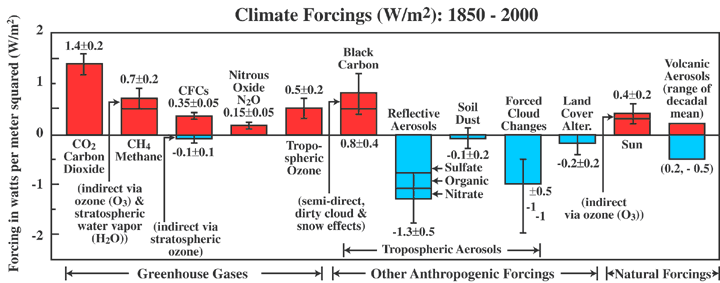Global warming and cooling today
The Earth's climate changed in the past; it will change in the future;
and it is changing now. It is important to how and why this happens.
The Solar Constant

It is possible to measure the warming power of the Sun. What
concerns Earth's inhabitants is the heating power of the light that falls on the
Earth. That is the solar constant and that turns out to be 1370 watts per square meter. It is important to
understand exactly what that means. 1370 watts is the power the Sun delivers to the
top of the atmosphere. Some of that power is absorbed by the atmosphere, and part
of it is absorbed at the surface and part of it is reflected back to space. The
Earth's albedo (defined in Climatology section) is known and so it is possible to calculate how much power is
reflected back to space. The Earth's albedo is 0.39. The product of 0.39 and 1370
watts is 534 watts and that is the power radiated back to space. The remainder,
1370 watts minus 534 watts is 836 watts and that is the power that keeps the Earth
pleasant and warm. [1]
The Earth is a sphere and so the Sun shines on one side at a time.
This cuts the average power in half. The parts of the Earth at sunrise and sunset and near
the poles are oblique to the suns rays and so they are warmed less. This cuts the
average power in half again. On the average, each
square meter of the earth receives 209 watts from the Sun. Two candles produce
about 209 watts of heat. An ordinary flashlight produces about 1 watt of heat.
Climate Forcings

The term "climate forcings" is widely used although it
does not seem to be defined anywhere. It means an event or a thing that influences
global climate.
The atmosphere and the oceans slosh about and so there are
variations in dryness or wetness or cold or heat. These short term variations
describe weather, not climate. They are not very significant in the big
picture. However, climate does respond to forcings. A volcanic eruption can
significantly cool the entire Earth. This would be an example of a short term
climate forcing. Continental drift occurring over millions of years changes the
path of ocean currents. This would be an example of a long term climate forcing.
Anthropogenic climate forcings have been added to natural climate
forcings. Fossil fuel burning and agriculture have a global effect on climate.
Climate forcing effects can be quantified. For example, it
has been determined that the additional carbon dioxide in the atmosphere produces
1.4 watts of heat on every square meter of the Earth's surface.
Not all anthropogenic forcings result in global warming. For
example, sulfur dioxide from coal burning produces reflective aerosols which result
in cooling.
 A NASA
(National Aeronautical and Space Administration) funded study published this
summary of the significant climate forcings. [3]
If you think of Earth as a spaceship (because it is), this summary would be
displayed next to the controls. A NASA
(National Aeronautical and Space Administration) funded study published this
summary of the significant climate forcings. [3]
If you think of Earth as a spaceship (because it is), this summary would be
displayed next to the controls.

The following observations may be made:
 Carbon dioxide is not the
only factor forcing climate. Carbon dioxide is not the
only factor forcing climate.
 Greenhouse gasses are not
the only factor forcing climate. Greenhouse gasses are not
the only factor forcing climate.
 There are many factors;
some positive, some negative. There are many factors;
some positive, some negative.
 Anthropogenic forcings
dwarf natural forcings Anthropogenic forcings
dwarf natural forcings
 The uncertainties are
large. The uncertainties are
large.
If you add all the bars, positive and negative, the net effect of all the forcings is
global warming.
Global warming is real and underway

Here is the evidence:
 Over the past 40 years, the
global temperature increased 0.5°C Over the past 40 years, the
global temperature increased 0.5°C
 Seven of ten of warmest years of
the century occurred in the 1990s. Seven of ten of warmest years of
the century occurred in the 1990s.
 Mountain glaciers all over the
world are receding. Mountain glaciers all over the
world are receding.
 The average ice thickness of the
arctic sea has decreased 40% in 40 years. The average ice thickness of the
arctic sea has decreased 40% in 40 years.
 World sea level is rising. World sea level is rising.
 At high latitudes, the growing
season starts 7 days earlier and ends 2-4 days latter. At high latitudes, the growing
season starts 7 days earlier and ends 2-4 days latter.
The large amount of sulfur dioxide released from coal burning has greatly reduced
global warming. The thermal capacity of the Earth's oceans and ice has greatly slowed
global warming.

[3] http://www.pnas.org/cgi/content/full/98/26/14778
Proceedings of the National Academy of Sciences. A full explanation of climate forcings.

|